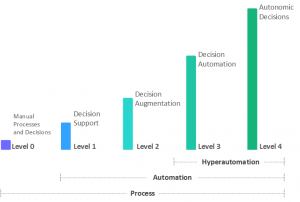Gartner first openly used the term "hyperautomation" in 2019. But what is it? How will it benefit your organization? And what are we hyperautomating?
In this post, I discuss what we are hyperautomating and how the convergence of technology and decision maturity made it possible. If you are still curious about why hyperautomation is important, read part one of this series first.
What are we hyperautomating?
I have identified four pillars to focus hyperautomation in an organization: customers, partners, suppliers and workforce. Although I discuss these individually, a single process may benefit more than one pillar.
Customers
Organizations map hundreds of processes describing how customers interact with the business. Through hyperautomation, organizations aim to achieve frictionless interaction between themselves and their customers. And the customer controls the timing and types of interactions. Both offline data and real-time interaction must inform business decisions, including apps, chat, website, phone calls or in-person in a high street store.
The next-best offers for subscription renewals or actions during customer care are well-trodden paths. However, business solutions also yield great benefits. Consider roles such as security underwriters, serving high-value organizations and the limited time available to determine the use of all the information available to determine exposure.
Partners
Successful partnerships depend on both tangible and intangible factors. These include trust, collaboration, knowledge sharing and organizational entrepreneurship. Building integrated and transparent processes supports successful partnerships. Consider a mobile network operator who adjusts service quality and slices capacity on shared 5G base stations and Radio Access Networks (RAN). Hyperautomation allows you to make governed, accountable decisions with consistency and scale.
Suppliers
Integration along the supply chain through open communications has the potential to drive efficiencies. Consider the agricultural industry, where sustainable yield is controlled by factors such as the level of provided nutrients to provide and affected by forecasted factors, such as the weather. You can scale and hyperpersonalize how much to feed and water and when to harvest for individual plots.
Workforce
Last alphabetically, but possibly the highest priority for organizations, at least in the short term. A 2021 IDC survey showed that organizations are prioritizing the hyperautomation of processes that support workforce connectivity and productivity. Providing a productive employee experience affects productivity and positive customer experience.
Objectives of automation
You can apply hyperautomation to a wide and diverse set of use cases. We can observe three phases as organizations approach automation, then hyperautomation.
- Reduce costs. In 2019 Gartner stated that IT departments can reduce operational costs by 30% through 2024 thanks to hyperautomation (Gartner Forecasts Worldwide Hyperautomation-Enabling Software Market to Reach Nearly $600 Billion by 2022).
- Increase productivity. A workforce free of repetitive tasks can achieve greater overall output and increase productivity.
- Innovation. Next, the focus becomes innovation. This creates and sustains competitive advantage by offering customers better products, services and overall experience. Hyperautomation is far more than simply adding AI to automation. By specifically employing low-code and no-code applications, teams simultaneously develop and compose solutions before testing and operationalizing successful innovations.
But the agility and speed of innovation with hyperautomation raises a question. How does an organization plan and measure its journey?
Decision maturity
Capability maturity models are an established method of defining and measuring progress toward such a goal. There are various maturity models for process automation, business analytics and business decisioning. A peer-reviewed hyperautomation maturity model seems to be lacking – perhaps an opportunity for future research? For now, I propose the stages of such a model, based on the following levels:
Level 0: Manual processes and decisions
This implies no automation exists, leading to inconsistency across the organization. The experience and knowledge individuals gain are slow and difficult to transfer between individuals.
Level 1: Decision support
This is recognized as an initial capability, where robotic process automation (RPA) supports process automation. Intelligence is added through descriptive analytics or some analytics, which are not easily and readily shared across the business. The process of operationalizing analytics is slow.
Level 2: Decision augmentation
Decision augmentation occurs when humans and automation work together. Decisions achieve consistent and repeatable actions through machine learning, natural language processing or another branch of artificial intelligence. The organization has proven its analytical models are fair and unbiased, while decisions made are transparent and auditable.
Level 3: Decision automation
Hyperautomation truly occurs when an organization recognizes decision automation. It can be said that hyperautomation occurs when processes contain thinking decisions. Processes are triggered, executed and concluded without the need for manual intervention. This leaves the workforce to intervene when it is valuable to do so or when legally required.
Business rules determine the decisions, informed by one or many branches of AI. Increasingly, multiple branches of AI are used simultaneously, referred to as composite AI. Organizations achieving this state are shown to benefit from increased products and services. This occurs because the workforce is now able to focus on the organization’s strategy and fewer tactical activities.
Gartner has commented that organizations that implement hyperautomation increase their products, revenues and workforce. This may seem counterintuitive to those who are concerned about workforce displacement.
Level 4: Autonomic decisions
This is the highest state of maturity. Here, processes continually learn, adapt and heal themselves. Many organizations I speak to are naturally cautious over the transition to a digital process from a team of people. In practice, this is likely to be staged over time, and some processes may never be appropriate for the autonomic level at all. However, many are, and organizations commonly use reinforcement learning techniques such as Fitted Q-Networks (FQNs) or real-time Deep Q-Networks (DQNs) to fulfill this capability.
Reinforcement learning is a fascinating subject in itself – you can read a blog post about it by Beth Ebersole.
Convergence
SAS describes hyperautomation as the convergence of digital operating systems (usually your cloud), workflow, RPA and AI. This delivers high-value autonomous processes through intelligent decisions. Ultimately, hyperautomation is the difference between making and acting on decisions.
Through its strategic partnership, SAS and Microsoft have uniquely integrated technology between Microsoft Power Platform and SAS Viya. This allows us to focus on delivering the best decisions, with the best processes, using responsible AI. How to do hyperautomation is discussed further in the next blog post.
To learn more about hyperautomation, visit www.sas.com/uk/hyperautomation.



